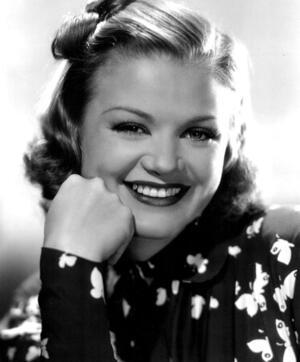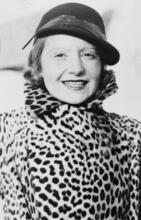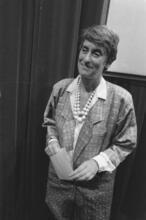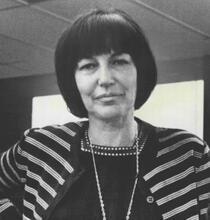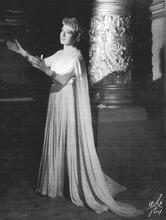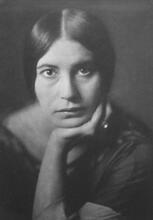Simone Simon
Simone Simon was recognized internationally for her smoldering on-screen combination of innocence and stealth, her undeniably iconic appearance and voice, as well as her prolific international film career. In 1934, her performance in Lac aux dames won her popular recognition in France and a contract offer from Darryl F. Zanuck with Twentieth Century Fox. She moved to Hollywood in 1936 and starred in a few minor films, most notably Girls’ Dormitory (1936) and Seventh Heaven (1937). Throughout her career, Simon developed an acting style that was vulnerable and seductive and earned major roles as a mysterious and alluring presence, yet she never attained the widespread visibility she deserved, as her French was an obstacle to mainstream success in Hollywood. Simon died in Paris in 2005.
Little is known about the Jewish background of Simone Simon, recognized internationally for her smoldering on-screen combination of innocence and stealth in such film classics as Jean Renoir’s somber adaptation of Émile Zola’s La Bête humaine (France 1938, with actor Jean Gabin) and Jacques Tourneur and Val Lewton’s cult horror film Cat People (USA 1942). What can be surmised, however, is that both her childhood and her adult career were marked by travel, at one point due to the virtual expulsion of Jews from France during World War II. Despite her undeniably iconic appearance and voice, as well as her prolific film career (38 feature films) in France, Hollywood, and later in Italy and Britain, as well as her theater performances, relatively little is known of Simon’s personal life. There are no memoirs, intimate accounts, or other means of estimating the impact of Jewishness on her life.
Film Career
Born on April 23, 1911, in Bethune (Pas-de-Calais), France, to a French father and an Italian mother, Simon spent her childhood in Marseilles and Madagascar and attended schools in Berlin, Budapest, and Turin. After a variety of jobs in her teens ranging from the fashion world to the music hall, she began making films in 1931, appearing in Le Chanteur Inconnu under the direction of Victor Tourjansky. Over the course of her career, Simon developed an acting style that was at once vulnerable and seductive. Her unusually delicate facial features, slanted eyes, and feline body-language earned her major roles as a mysterious and alluring presence, yet she never attained the widespread visibility that her work with a host of impressive directors, such as Jean Renoir, Marc Allégret, and Max Ophuls, should have secured, always remaining something of a character actress associated with the shadows that seemed to surround her private life. A singer (who performed with the mother of another French actress, Danielle Darrieux), a model, and a fashion designer in Paris, she made her first five films in 1931, among them Mam’zelle Nitouche and La Chocolatière for Marc Allégret, who then directed her in her first acknowledged success, Lac aux dames (1934). Scripted by Colette, the film won her popular recognition in France and a contract offer from Darryl F. Zanuck with Twentieth Century Fox. In 1934, after having seen Simon’s performance in an operetta, Colette wrote: “Twenty years old, no nose to speak of, an extraordinary dash, vigor of movement, a precise little voice, eyes wide apart, like a purebred Pekinese pup, she’s learned the ropes in cinema and marvelously understands scenic direction.… She has something else, that indefinable thing that holds your attention, that keeps you thinking.” It was this quality, read as foreignness, which ensured her success in Hollywood when she moved there in 1936. She starred in a few minor films, most notably Girls’ Dormitory (1936) with Tyrone Power, and Henry King’s remake of Frank Borzage’s popular melodrama of the silent period, Seventh Heaven (1937). But a falling out with Fox made her return to France, where the international success of La Bête humaine in 1938 brought her new recognition—until the war.
Post-War Career
With the fall of France in 1940, Simon moved back to Hollywood to work for RKO Studios. In William Dieterle’s The Devil and Daniel Webster (1941), her role as a succubus, a female demon who uses her sexuality to destroy men, capitalized on what was to become her signature feature in Cat People and its sequel, The Curse of the Cat People (Robert Wise, 1944)—a beguiling yet menacing appearance that associated sexuality with the occult.
While Simon’s French accent augmented the exoticism of her image, it was also an obstacle to mainstream success in Hollywood. At any rate, after the war she returned to France, where she made two classic films with Max Ophuls, La Ronde (1950) and Le Plaisir (1951), demonstrating what was now a more mature and nuanced form of sensuality. She retired from films in 1956 but returned to the screen in 1972 for Michel Deville’s tribute film, La Femme en bleu. In life as on the screen, Simone Simon remained discreet and mysterious, a powerful yet secretive presence.
Legacy
Simon, who never married, died in Paris on the night of February 22–23, 2005. Eulogizing her, France’s minister of culture, Renan Donnedieu de Vabres, said, “We have lost one of the most seductive, most radiant actresses of the twentieth century. … We will keep in memory for a long time the trace of that undefinable something that made this very beautiful actress so endearing.”
Selected Filmography
Le chanteur inconnu, Mam’zelle Nitouche 1931.
Lac aux dames 1934.
Les yeux noirs 1935.
Girls’ Dormitory, Ladies in Love 1936;
Seventh Heaven 1937.
Josette, La Bête humaine 1938.
The Devil and Daniel Webster 1941.
Cat People 1942.
Mademoiselle Fifi, Curse of the Cat People 1944.
Petrus 1946.
Donne senza nome 1949.
La Ronde, Olivia 1950.
Le Plaisir 1952.
I tre ladri 1954.
The Extra Day 1956.
La Femme en bleu 1972.

